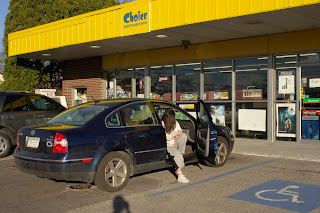Chester Paragraph
The first photographer I’m writing about here is Edward Burtynsky, and the book is Manufactured Landscape. The pictures in the book are just stunning, and notably the most interesting part is, although these suppose to be landscapes, they do not look like the usual landscapes we think about. They are landscapes that are created by human.
The subjects he photographs are usually not considered beautiful, but through his photographs, Burtynsky extracts the beauty from the scene, and also the ugly reason that caused such scenery. The very first thing that I noticed is his photos often lacks something in there for scale. You can’t tell if its only a small hill or a gigantic mountain on the first look. And the ones that do have something you can recognize to comprehend the scale of the subject, the photograph often highlight the enormity very well. (You don’t know how big those rocks in the quarry field until you see some tiny people standing right next to it. He uses a lot of repetition of patterns in his URBAN MINES, and OIL FIELDS AND REFINERIES chapters, like the repetition of tires, tubes, which neatly fits the frame, and don’t feel distracting. Also, the way he captures color is amazing. He often uses extreme contrast of color to frame the picture and highlight the subject. The most unforgettable is the orange river, the stark contrast between the vibrant orange river and the barren background is so striking, that you will instantly think that there must have been something terrible happened here to generate such a beautiful, yet extremely horrible sight. Didn’t find anything about what he used for the modern photographs, but he used 4x5 field cameras before 2007 so probably a lot of the photos in this book are taken with field cameras using films.
The second one is Mike Melman, author/photographer of The Quiet Hours. All the photos are black and white, and judging by the time it was taken, I would assume he used film cameras, not sure what format it was. The subjects are basically a small corner of a town, but without anyone visible in the frame, they are all taken during late night or very early mornings. What interests me is how he frames the subjects. No matter if it’s a building, a bridge, some trains, etc. He places them in the frame in a pretty elegant way, so it feels no motion exists (excluding the one with smoke coming out of a chimney). The photos are often low with contrast, and there isn’t a spot on the photo that really pops out and screams for your attention. You really need to look at the whole picture to get what the photographer is trying to deliver. The almost serene feel really complements those photographs well, and with the often-symmetric framing, with the camera at a standing height (so no looking up nor looking down on to something) the photos really do feel very peaceful, though shows somewhat desolate and the loneliness of the town. And because the absence of any human being in the picture, the viewer can better appreciate the subjects even better.
The third one is Steve McCurry, whose photography are more about people, and news around the world, particularly about people lived in conflict and war. He used a Nikon FM2 film camera for a lot of his works including his most famous one: Afghan Girl. What strikes me the most is the way McCurry captures people in his photos, just as what we discussed in class: with enough dignity. The subjects in the photos might be poor and live in a turbulent environment, but they always look right into the lens, some expresses more emotions than others, but never the less, they are all dignified human figures. Also, the way he chooses his subjects and how he frames them are interesting as well. There is always a story unfolding when the images were captured, and the narrative was captured perfectly. Even without any context and explanation, the viewer can almost feel the movement of the subjects, and the emotions lies behind. Some of his war time photos looks a bit dull in color, but I guess that is what he is after: the aftermath of war and destruction. But in most images, there are a lot of contrasting colors in the frames, and I find him likes to use red, to perform some sort of contrasting color, like red scarf of the Afghan girl contrasting with the green background, the clothes of the monks with the dull grey background, the man covered in vibrant green contrasting with people. Covered with red, and the red eyes of the sea bird covered in pitch black oil.



Comments
Post a Comment